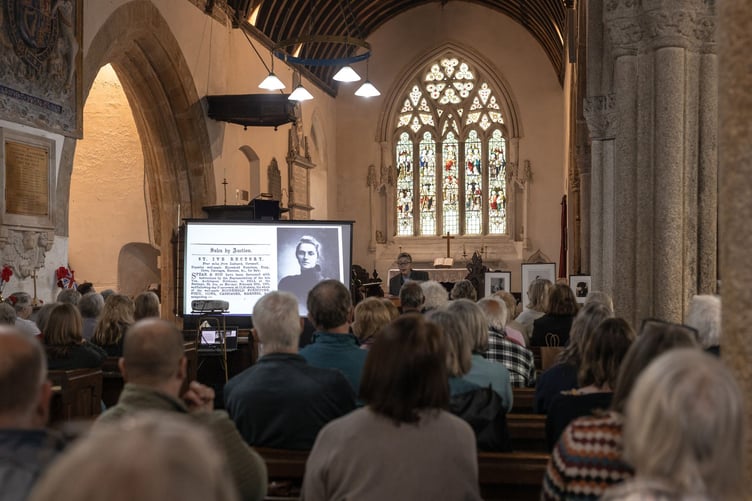Cornish humanitarian and pacifist Emily Hobhouse was celebrated in April with the unveiling of a bust marking her 165th birthday.
Guests were invited to a day of commemoration of the heroine whose involvement in the Second Anglo-Boer war is depicted in the immersive experience The Story of Emily based at the site of her family home in St Ive just outside Liskeard.
The celebrations began on April 12 with a special talk about Emily's life at St Ive Church, exploring the extraordinary experiences she had on her birthday while travelling the world. These were followed by the unveiling of a bust commemorating this very Cornish heroine in the Rectory kitchen gardens.
Award-winning South African journalist and Emily Hobhouse biographer, and consultant on the St Ive immersive experience Elsabé Brits spoke to the congregation of guests in the church where Emily’s father had been rector.

Beginning her speech to the audience Elsabé said: “What a fantastic place to celebrate the 165th birthday of Emily Hobhouse. In this historic church, she and her family attended her father's services. It is also where she was baptised in May 1860.
“Join me in celebrating her life through time; where she was and what she did around her birthday, which was on the 9th of April.
“Emily Hobhouse would become both famous and infamous in her lifetime. Revered by some, loathed by others. However, today, her humanitarian actions, pacifism, feminism, and the words she spoke and wrote remain acutely relevant.”
Elsabé then began a whistle-stop tour of the aspects of Emily’s life which are depicted in the award-winning building on the St Ive rectory site which is the home immersive experience.
She said: “Three weeks after the Anglo-Boer War broke out, Emily became involved in the South African Conciliation Committee. This committee was opposed to the war and advocated for the self-determination of all countries.
“By April 1900, she wrote: ‘We longed to protest, and it occurred to me that women, at least, might make a public protest against injustice. That it should be known as a matter of history that we women did so. Three thousand women from all across the country attended this meeting at The Queen's Hall in June 1900’.”

Why did she go thousands of miles away? On her own, to a war-torn country? When the landscape, culture, language and climate were so different from here, the award-winning journalist asked the guests.
She continued: “Emily wrote: ‘The constantly renewed picture of women and children homeless, desperate and distressed formed and fixed itself in my mind, and never once left me. It became my abiding thought. The thought deepened to torture.”
Elsabé explained “She had to go, she felt. Aware of the international events of the day, well-read and intelligent, Emily was driven not by religion but by an inner moral conviction.
“When Emily Hobhouse arrived in Cape Town on the 27th of December 1900, she learned for the first time that women and children were forced into concentration camps. Kitchener refused her the company of another female on her travels north to the concentration camps. Her journey to Bloemfontein lasted five gruelling days, and she was the only female on the train, packed with British soldiers.
“For the next four months, she travelled between several camps, distributing clothes and food and, most importantly, compiling evidence for her report. And serving as an eyewitness to the sufferings of women and children in war. A significant challenge was to speak to male authority during wartime.”
On her 41st birthday, she arrived at the town of Mafeking in the far north of the Cape Colony to visit a camp, explains Elsabé.

Here, she experienced firsthand another consequence of the war known as the sweepings; a tactic employed by the British forces ‘sweeping’ through the countryside to disrupt the Boer fighters, their support networks, and their ability to move freely.
Elsabé continues: “Emily wrote, ‘Those truckloads of women and children unsheltered and unfed, bereft of home, bearing the vivid recollection of their possessions in the flames. And, that mass of the sweepings, of a wide military drive.’
She described the scene: “Flocks and herds of frightened animals bellowing and baaing for food and drink. Tangled up with wagons and vehicles of all sorts and a dense crowd of human beings. It combined to give a picture of the war in all its destructiveness, cruelty, stupidity and nakedness, such as not even the misery of the camps, with their external appearance of order, could do.”
But Emily was primarily alone when she witnessed this; there was no one to talk to. No sounding board, explains Elsabé.
“When her concentration camp report was published, Emily found herself at the centre of a political war, which, by its nature, was a war with few rules. The imperialists discredited her integrity as an eyewitness and whistleblower to soften the blow of the report. She was described as a liar, a hysterical woman, and a traitor.

“It was thought that what she did was improper for a lady and that she was unqualified for the task because women knew nothing of ‘war and its evils’.
On another of her birthdays, in 1902, an article by Emily was published in the Manchester Guardian, says Elsabé. “In it, she included letters from women sent to her, who described the conditions in the camps, which had vastly improved, yet [which] they were still not allowed to leave.
“Then Emily threw her punch: ‘Case, after case of the detention of innocent women and girls was heard of. But once the liberal spirit of England is quenched, such things no longer rouse it.’
After the talk, guests were invited to join in with a slice of birthday cake and a celebratory toast to Emily Hobhouse, and to let their imagination take flight by creating and flying kites with celebratory messages to Emily, while local St Ive resident Doreen Cardew was tasked with unveiling the bronze bust by the LA artist Lynn Christopher.

The bust was commissioned in 2019 to celebrate the spirit of this true heroine of Cornwall who was more beloved in South Africa then the place of birth. It was created for her former home to help right the wrong and bring about the “reinstitution of Emily in the public mind of England”, something which she wrote about, and which is the aim of the immersive experience in St Ive, according to Elsabé.
Celebrations continued after the birthday event as The Story of Emily museum was awarded the RIBA South West and Wessex Building of the Year for 2025 for the building which houses the War Rooms at The Story of Emily which tells the story of Emily’s role in the war.
A spokesperson for the immersive experience said: “Working with the exceptional team at Stonewood Design, this project has been a true labour of love, blending Cornwall’s natural beauty and architectural heritage to create a space that honours the life and legacy of Emily Hobhouse.
“From sensitively restored farm buildings to bold new additions like our glazed restaurant and zinc-clad exhibition hall, the site was designed to offer a powerful, immersive and inclusive visitor experience.”
More information on the Story of Emily can be found at their website at: www.thestoryofemily.com.





Comments
This article has no comments yet. Be the first to leave a comment.